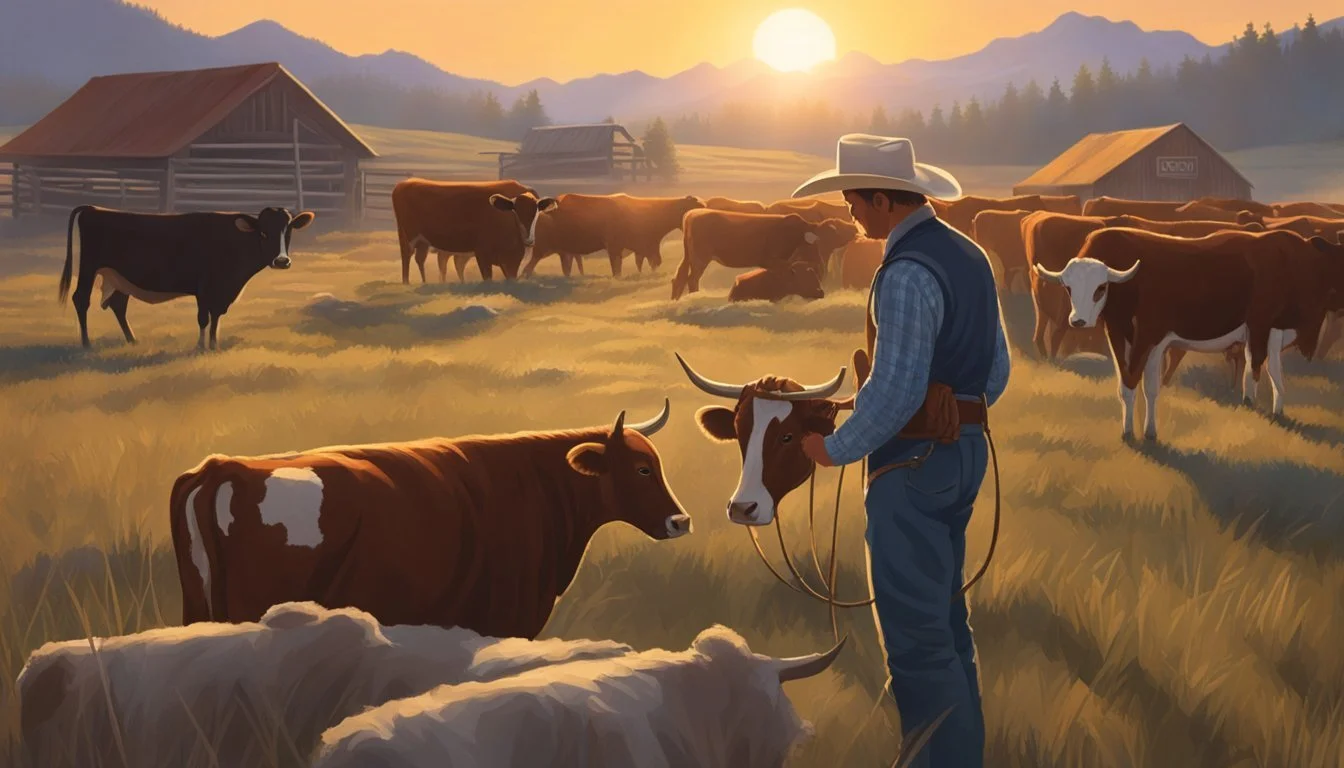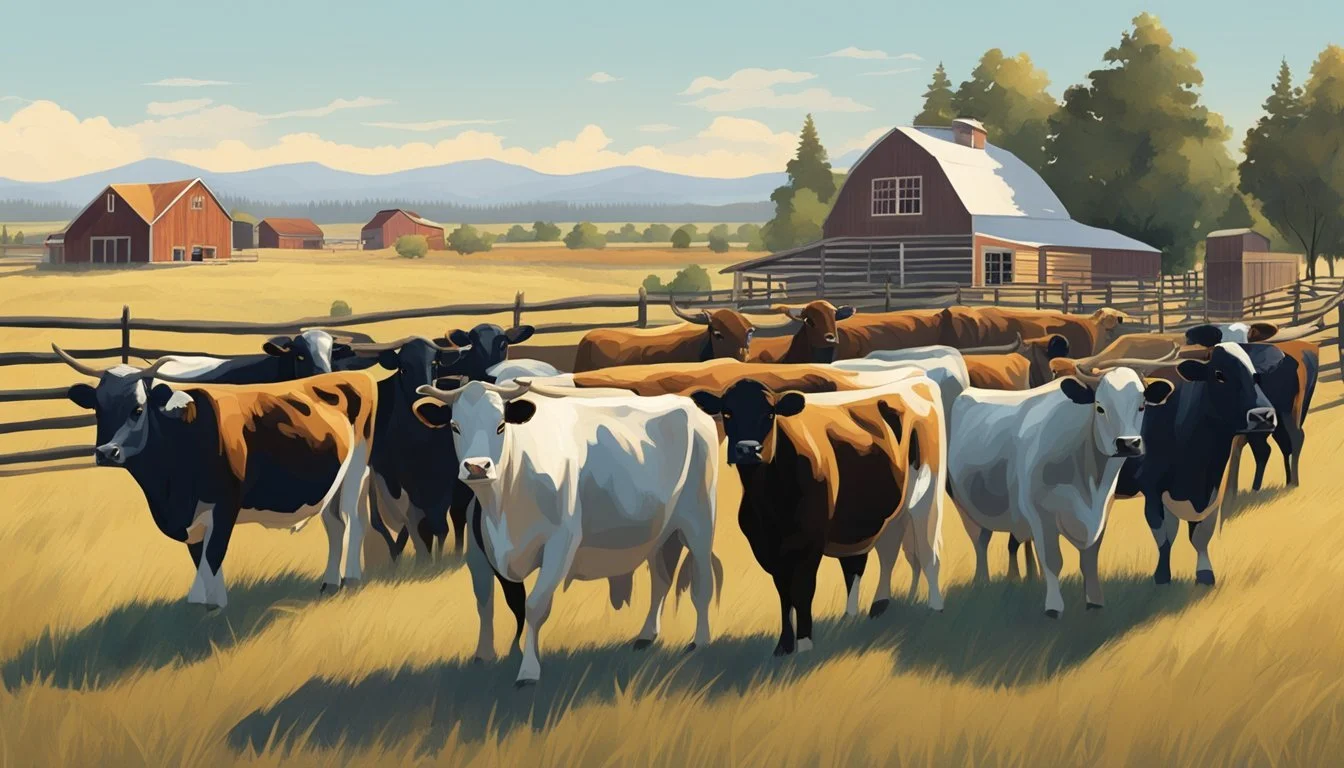The Ultimate Guide to Cattle Branding Irons
Ensuring Permanent Identification on Your Homestead
Cattle branding has been an essential part of livestock management for centuries, serving as a means of establishing ownership and aiding in the identification of individual animals within a herd. Branding irons, the tools used to create these permanent marks, come in various forms, each designed to leave a clear, lasting symbol on the hide of cattle. The practice not only indicates ownership but also plays a role in herd management, allowing farmers to track and manage their livestock more efficiently.
Selecting the right branding iron is crucial for ensuring the branding process is effective and minimizes stress on the animals. Traditional hot iron branding and modern methods like freeze branding each have their own sets of equipment and procedures. When branding cattle, it is important to consider the welfare of the animals and the permanence of the identification, making sure that the chosen method results in a legible and durable mark while also conforming to animal health regulations and standards.
Branding represents an intersection of animal husbandry and property management, offering a system that withstands the test of time. Today's cattle owners have a range of tools and techniques at their disposal to ensure each animal carries a permanent ID that can aid in various management tasks, as well as help in preventing theft. The proper implementation of cattle branding irons contributes to an organized and efficient operation, embodying the blend of tradition and modernity on the homestead.
Understanding Cattle Branding
Cattle branding has served as a pivotal tool for livestock management, providing permanent identification and emphasizing ownership.
History and Significance
Cattle branding has historical roots spanning centuries, originally serving as a deterrent against theft and a means to assert ownership. It emerged as a practical response to the challenge of managing free-ranging livestock. Today, branding is not only a symbol of ownership but also a tradition that embodies the rich heritage of livestock farming.
Types of Branding Irons
Different types of branding irons are utilized to mark animals. The three common types are:
Hot Branding Irons: These are typically heated in a fire or with a propane burner and used when the iron reaches a cherry red color.
Freeze Branding Irons: They use extreme cold, often with the help of liquid nitrogen or dry ice and alcohol, to alter the pigment-producing hair cells, resulting in white or colorless hair growth.
Electric Branding Irons: These irons plug into an electrical source to heat up and are preferred for their consistent temperature control.
Each method has its own set of advantages and best-use scenarios:
Hot Branding: Advantage - Fast and effective for dark-haired livestock
Freeze Branding: Advantage - Visible on animals with light-colored hair; less damage to the hide
Electric Branding: Advantage - Precision in temperature control, leading to consistent brands
Determining the Best Branding Method
When choosing the best branding method, one must consider several factors to ensure effective and permanent identification. The type of livestock, color of their hair, size of the brand, and working conditions, such as access to electricity, influence this decision. Also, animal welfare and the potential impact on the value of the hide need careful consideration. For instance, a study found that brand size and location could affect the hide’s value, with some brands potentially diminishing it. Therefore, selecting the most suitable branding method is critical to balance practicality, efficiency, and animal well-being.
Preparing for Branding
Branding is a critical process for cattle identification that requires careful preparation and attention to detail. Ensuring that you have the right supplies on hand and that both the branding area and the livestock are properly prepared will facilitate a smooth branding operation.
Supplies Needed
A successful cattle branding operation begins with assembling all necessary supplies. Below is a list of items required for the branding process:
Branding Irons: Specific to the chosen brand design.
Coolant: Liquid nitrogen or dry ice for freeze branding.
Isopropyl Alcohol (99% pure): For prepping the skin and cleaning equipment.
Clippers: To remove hair from the branding area.
Squeeze Chute: To securely hold the cattle.
Gloves and Safety Gear: To protect the handler.
Timer: Critical for tracking the time the brand is applied.
Selecting the Brand Design
The brand design is a unique symbol representing the owner's identifier and must be registered with the appropriate livestock agency. When selecting a brand design, one should ensure that it is:
Simple and clear to prevent misidentification.
Unique to avoid overlap with other brand designs in use nearby.
Sized appropriately to ensure legibility and minimize impact on the animal's hide.
Setting Up the Branding Area
The branding area should be a clean, well-organized space within a cattle working facility that allows for efficient workflow and minimizes stress on the animals. It must have:
Adequate lighting and ventilation.
Access to the squeeze chute for safe restraining of the cattle.
Sufficient space for handlers to move and operate safely.
An area to store branding supplies and coolants securely.
Handling and Restraining Livestock
It's imperative that cattle are properly restrained to ensure safety and precision during branding. The use of a squeeze chute enables the handler to:
Secure the animal and limit its movement.
Provide access to the specific area to be branded.
Minimize stress on the cattle and risk of injury to both the livestock and handlers.
Proper restraint is also essential for applying the brand consistently to the designated brand location, ensuring legible and individual animal identification.
Hot Iron Branding
In the realm of cattle identification, hot iron branding is a traditional and widely adopted technique for marking livestock effectively and permanently. This method utilizes heated metal brands to create a distinct mark on the hide of cattle.
Types of Hot Iron Brands
Materials:
Steel: Commonly used for its durability and excellent heat conduction.
Brass: Less common, retains heat longer but can be more expensive.
Sources of Heat:
Traditional fire (wood or coal burning)
Propane burner
Electric heating element
To achieve proper branding, the iron must reach the correct temperature, often described as a "cherry red" or around 500 to 600 degrees Fahrenheit. A brand that is too cool may result in poor marking, while an overly hot brand can cause excessive scarring.
The Branding Procedure
Preparation:
The cattle should be securely restrained in a chute or a calf table.
Removing excess hair from the branding site is advised for clear marks, especially on light-colored cattle.
Applying the Brand:
Place the hot iron against the animal's hide with moderate pressure.
Timing is critical: approximately 10 seconds, depending on weather conditions and hide thickness.
A dark copper coloration on the skin signals successful application.
Cooling:
After branding, irons should be returned to the heat source or placed on a non-flammable surface to cool safely.
Regular cleaning and correct storage in a dry location are essential to maintain the irons' condition.
Caring for Hot Branded Cattle
Once branded, the cattle's marked areas should be monitored for proper healing. A scab formation is normal and eventually flakes off. One should ensure the animals are kept in clean conditions to avoid infections. Over time, the brand may result in a bald or bare area where the hair grows back lighter or not at all, providing a clear identifier for the lifetime of the cattle. Proper technique minimizes the risk of excessive scarring and helps ensure animal welfare standards are met.
Freeze Branding
Freeze branding is a method of permanent cattle identification that is less painful and minimizes hide damage compared to traditional methods. It involves the use of extreme cold to alter the pigment-producing cells, resulting in a distinctive white hair growth in the branded area.
Materials for Freeze Branding
To effectively conduct freeze branding, one requires specific materials:
Branding Irons: Typically made from copper alloy or stainless steel for optimal temperature conduction.
Coolant: Liquid nitrogen or a refrigerant mixture of dry ice and isopropyl or denatured alcohol.
Clippers: To shave the area where the brand will be applied, ensuring a clear mark.
Gloves and Safety Gear: To protect from extreme cold and handling of chemicals.
Performing the Freeze Branding
Preparation:
Shave the area to be branded, removing thick hair for better visibility.
Soak the iron in the coolant until it reaches the required low temperature (at least 20 minutes initially).
Application:
Apply the brand with consistent pressure to the skin for the correct timing (ranging from a few seconds to a minute depending on animal age and skin thickness).
The timing is critical to achieving a clear, legible mark without excessive hide damage.
Aftercare for Freeze Branded Cattle
Post-branding care includes:
Monitoring: Watch for the area to heal and the white hair to grow, which may take several months.
Hair Clipping: Regular clipping around the branded area can improve the visibility of the freeze brand.
Avoiding Irritants: Keep the brand site clean and avoid irritating substances to promote proper healing and prevent infections.
Implementing these practices can result in a legible and permanent freeze brand with minimal discomfort for the cattle.
Permanent Identification Beyond Branding
Permanent identification methods for cattle are essential for effective herd management, beyond the traditional hot iron and freeze branding techniques. These alternative methods facilitate the tracking of individual animals for breeding, sales, and health management purposes.
Ear Tags and Tattoos
Ear tags are a popular method for cattle identification. They are typically made of durable plastic and come in a variety of colors and sizes, which can carry a wide range of information, from simple identification numbers to more detailed data about the animal. Tags can be applied with a special tagging tool that inserts the tag through a small incision in the ear.
Plastic ear tags are often preferred because:
Visibility: They are easily visible from a distance.
Information: They can display numbers, letters, or barcodes.
Color coding: Different colors can signify different information about the cattle, such as age or vaccination status.
Ear tattoos provide a more permanent solution compared to ear tags, which can become detached or lost. They are applied by using a tattooing instrument that inserts ink into the inner layer of the ear.
Benefits of ear tattoos include:
Permanence: Less likely to fade or be lost over time.
Tamper-resistance: Difficult for unauthorized individuals to alter.
Microchipping and Other Modern Techniques
Microchipping is becoming a more commonly used technique for permanent animal identification. A microchip is a small electronic chip enclosed in a glass cylinder, roughly the size of a grain of rice. It is injected under the animal's skin, typically in the neck region, and can be read with a microchip scanner.
Key points about microchipping:
Unique Identification: Each microchip contains a unique identification number.
Durability: Microchips are designed to last throughout the animal's lifetime.
Global Standard: The microchip technology follows international standards for animal identification.
Other modern techniques might include sophisticated systems involving genetic markers or advanced electronic data management systems linked to identifiers, which assist in comprehensive herd management. Technology continues to evolve in the sphere of animal identification, providing diverse options beyond traditional branding for cattle ranchers and homesteaders.
Record Keeping and Management Considerations
Effective cattle branding involves more than the mere application of marks; it serves as a foundation for meticulous herd record keeping, offers a distinct marketing advantage, and necessitates awareness of legal obligations associated with branding practices.
Herd Record Keeping
In managing a homestead, herd record keeping plays a vital role in maintaining the health, productivity, and profitability of the herd. Selection decisions for breeding and sales are based on accurate records, which include birth dates, lineage, and health histories. Each animal's brand acts as a unique identifier, correlating to records that track important events such as pairing up cows and calves, treating injured or ill cattle, and estrus detection. Brands should be clearly readable and legible at a distance to ensure they serve their purpose effectively in record keeping.
Brand as a Marketing Tool
A distinctive, well-designed brand can act as a powerful marketing tool for homesteaders. It not only assures buyers of a legible identification mark but can also become synonymous with the quality and reputation of the livestock. When the brand is consistently associated with superior genetics, health, and care, it adds value to the cattle and can be leveraged for better market positioning.
Managing Legal Aspects of Branding
It's essential to recognize the legal implications of cattle branding. Each state may have its own regulations regarding the design, registration, and use of branding irons. The owner must ensure the brand is officially registered and does not infringe on another's design. Legal management also includes maintaining up-to-date documentation to establish ownership and aid in the recovery of lost or stolen livestock. Compliance with these legal aspects prevents possible disputes and solidifies the owner's claims.
Tips for Effective Cattle Branding
Effective cattle branding ensures permanent identification, is crucial for homestead management, and deters theft. A focus on legibility, safety, and equipment maintenance is pivotal for a smooth branding process.
Ensuring a Legible and Attractive Brand
Creating a brand that is both legible and attractive involves careful design and proper technique. They should:
Design the brand for readability from a distance and ensure it encapsulates the homestead’s unique symbol or initials without being overly complex.
Test the brand on a piece of wood or leather to view the actual print before applying it to livestock.
Achieve good contact between the branding iron and the animal's hide by applying even pressure and slight movement to prevent blotching.
Ensure the brand is not held against the hide too long to avoid deep scarring.
Safety Measures and Precautions
Safety for both livestock and the crew during branding is paramount:
Train the crew on basic livestock handling and establish clear communication protocols.
Employ effective cattle handling practices that promote low-stress environments for the animals.
Use protective gear, such as gloves and eye protection to prevent accidental burns.
Ensure a safe distance is maintained between the branding fire and the working area to mitigate the risk of accidents.
Maintaining Branding Equipment
Proper maintenance of branding equipment promotes safety and extends the lifespan of the tools:
Regularly clean branding irons with a wire brush to remove residue and check for defects, such as cracks.
Inspect equipment post-use for any signs of wear or damage and promptly replace pieces as needed to maintain functionality.
Store irons in a dry environment to prevent rust and deterioration.
Keep track of warranty periods for the equipment to address any issues arising from manufacturing defects.
Each step, when implemented faithfully, contributes to an efficient and humane cattle branding operation.
Considerations for Specific Cattle Breeds and Conditions
When branding cattle, it's crucial to account for breed-specific characteristics and environmental factors that can affect the process. Different hide types and growth stages necessitate tailored approaches to ensure successful and permanent identification.
Adapting to Different Hair and Hide Types
Cattle hides vary in thickness, color, and hair density, influencing the branding iron's heat setting and application time. Angus cattle, for example, often have a black, thicker hide necessitating a slightly higher temperature or longer application to ensure the brand is legible. Conversely, cattle with a new hair coat or those in Texas's hotter climate may require a cooler iron and quicker application to prevent skin damage.
Special Considerations for Dairy Cattle
Dairy cattle, with their high value for milk production, require a careful branding approach to avoid distress or skin damage that could impact their performance. Their hides are typically thinner and more sensitive, so lower temperatures and swift branding are imperative. Specifically, dairy breeds may need:
Reduced heating time
Quick, precise application
Immediate post-branding care
Challenges with Young and Thin Cattle
Young cattle, such as yearlings, and thin cattle are more susceptible to deep burns due to their less developed hides. For these groups, one should:
Use a lower temperature
Brand for a shorter duration
Monitor for any signs of stress
In all cases, it's important to regularly evaluate and adjust the branding process based on the cattle's reaction and the initial branding results, always striving for the well-being of the animals while ensuring permanent identification.







